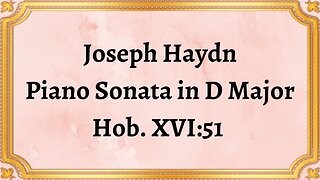Premium Only Content

Joseph Haydn Symphony №93 In D Major
#classicalmusic #JosephHaydn #SymphonyNo93 #DMajor #musicalcomposition #orchestra #classicalcomposers #musicappreciation #musictheory #violin #cello #conductor #classicalconcerts #musichistory #baroque #classicalera #musicperformance #classicalinstruments #symphony #composer
Publication date 1951
Sir Thomas Beecham; The Royal Philharmonic Orchestra
Classical music has always been revered for its ability to evoke emotions and transport listeners to different realms. Among the countless compositions that have stood the test of time, Joseph Haydn's Symphony No. 93 In D Major holds a special place.
Composed in 1791, Symphony No. 93 is part of Haydn's prolific series of symphonies known as the "London Symphonies." These symphonies were composed during Haydn's two visits to London, where he gained immense popularity and admiration for his music. Symphony No. 93 is one of the twelve symphonies from this collection, each showcasing Haydn's mastery of orchestration and his innovative approach to composition.
Symphony No. 93 consists of four movements, each distinct in character and mood.
The symphony begins with a slow and solemn Adagio, setting a contemplative atmosphere. This is followed by the energetic Allegro assai, where the orchestra bursts into life with a lively and spirited melody. The contrasting dynamics and tempos in this movement create a sense of anticipation and excitement.
The second movement, Largo cantabile, is characterized by its lyrical and melodic nature. The orchestra delicately weaves a beautiful tapestry of harmonies, allowing the listener to immerse themselves in a world of serenity and tranquility.
Next comes the Menuetto and Trio, a dance-like movement that showcases Haydn's adeptness at composing elegant and graceful melodies. The playful and rhythmic nature of this movement brings a sense of joy and lightness to the symphony.
The symphony concludes with a lively and spirited Finale - Presto. The orchestra engages in a musical dialogue, with various sections conversing and intertwining with one another. The energetic and fast-paced nature of this movement leaves the listener exhilarated and captivated until the final notes.
Joseph Haydn Symphony No. 93 In D Major holds immense significance in the classical music landscape. It represents the pinnacle of Haydn's compositional career and showcases his innovation and mastery of orchestration. The symphony's seamless blend of contrasting moods, intricate melodies, and engaging rhythms captivates audiences even to this day, highlighting Haydn's ability to create music that transcends time.
Conclusion:
In the vast world of classical music, Joseph Haydn Symphony No. 93 In D Major stands as a testament to the genius of one of the greatest composers in history. Its intricate structure, captivating melodies, and emotional depth continue to captivate audiences, reminding us of the timeless beauty and power of classical music.
You have the opportunity to support the channel:
https://destream.net/live/RadSiarAl/donate
https://www.buymeacoffee.com/6355radsiaral
-
 6:07
6:07
Classical music_Music Inspiration
24 days agoJoseph Haydn Piano Sonata in D Major, Hob. XVI:51
701 -
 LIVE
LIVE
Steven Crowder
1 hour ago🔴 WINNING: Why Trump Has John Oliver & All of Europe Freaking Out
57,303 watching -
 LIVE
LIVE
Bannons War Room
16 hours agoWarRoom Live
17,888 watching -
 LIVE
LIVE
Wendy Bell Radio
5 hours agoCHECKMATE
12,602 watching -
 LIVE
LIVE
VSiNLive
35 minutes agoA Numbers Game with Gill Alexander | Hour 1
136 watching -
 LIVE
LIVE
Matt Kohrs
10 hours agoPumping To New Highs, Memecoin Mania & The Week Ahead || The MK Show
1,438 watching -
 42:05
42:05
BonginoReport
4 hours agoPothole Pete Blames Plane Crash in Canada on Trump (Ep.142) - 02/18/2025
64.2K116 -
 1:13:40
1:13:40
Graham Allen
3 hours agoDOGE Is Going After The IRS!! Mass Firing Soon!! + ANOTHER Plane Crash! We Are Not Safe…
35.5K10 -
 LIVE
LIVE
Randi Hipper
48 minutes agoArgentina's Meme Coin Disaster: Inside the LIBRA Crash
99 watching -
 DVR
DVR
Chicks On The Right
4 hours agoCrazy plane crash, crazy lib protests, and Deborah Birx can suck it
12.5K5